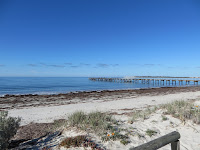As we
traveled north we spent one night at Mataranka Bitter Springs Caravan Park.
This is right next to the entry to Elsey National Park and walking distance
from the warm springs and swimming spots in the creek. Most enjoyable!
We passed
through Katherine and on to Kakadu National Park were we had booked 5 days
stay, promising ourselves a visit to Katherine Gorge on the way south again.
As we drove
into Kakadu we were surprised by the hilly country we passed through in the
south of the park and the grassy, lightly treed savannah country. We expected
it to be mostly wetlands as featured in all the publicity. There was quite a
lot of burning off happening but this is normal at this time of year. Seasonal
burning has been part of the aboriginal land management for many thousands of
years. Small fires when the winds are light prevent large hot destructive
fires. As the fires are small the animals can escape them and they do not
destroy all the trees. The vegetation recovers quite quickly, new grass grows
encouraging animals into the area.
The
highlight of the Kakadu experience was a cruise at Yellow Waters on the South
Alligator River where there are huge areas of floating grasses with passages
through with waterlilies, thousands of birds and of course, salt water
crocodiles. The water was glassy smooth and the day perfect, the bird life was
amazing. In the wet season most of these trees would be under water, but as the dry season progresses the water level will drop and dry mud banks will be exposed.
We spent a
day exploring the northern part of the park where there are ancient rock
escarpments with aboriginal rock art under sheltered overhangs.























